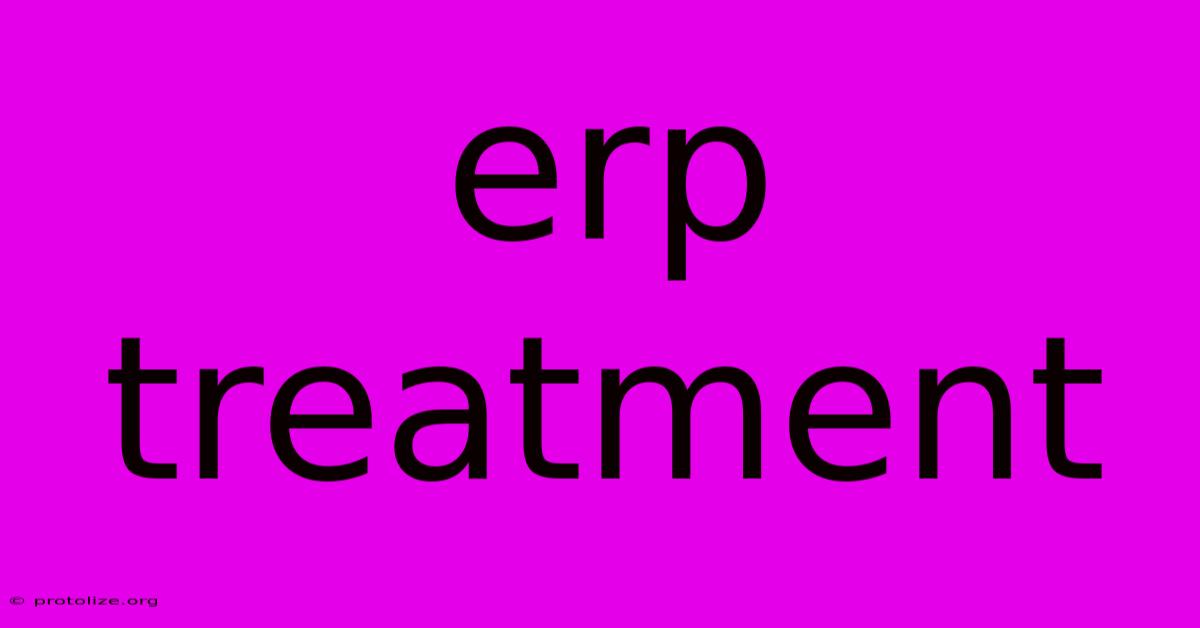Erp Treatment

Discover more detailed and exciting information on our website. Click the link below to start your adventure: Visit Best Website mr.cleine.com. Don't miss out!
Table of Contents
ERP Treatment: Understanding and Managing Obsessive-Compulsive Disorder
Obsessive-Compulsive Disorder (OCD) can significantly impact a person's life, causing distress and interfering with daily activities. Fortunately, effective treatments are available, and Exposure and Response Prevention (ERP) therapy stands out as a leading evidence-based approach. This comprehensive guide will delve into ERP treatment, explaining its principles, process, and benefits.
What is ERP Therapy?
ERP therapy is a type of cognitive-behavioral therapy (CBT) specifically designed to treat OCD. It targets the core features of OCD: obsessions and compulsions. Obsessions are intrusive, unwanted thoughts, images, or urges that cause significant anxiety. Compulsions are repetitive behaviors or mental acts performed to reduce the anxiety caused by obsessions.
The core principle of ERP is to help individuals confront their fears and anxieties associated with obsessions without engaging in compulsive behaviors. This process gradually reduces the power of obsessions and the need for compulsions.
How Does ERP Work?
ERP treatment involves two main components:
-
Exposure: This involves gradually exposing the individual to the feared situations, thoughts, or objects that trigger obsessions. This exposure can be real-life situations or imagined scenarios. The goal is to experience the anxiety without resorting to compulsions.
-
Response Prevention: This crucial element involves resisting the urge to engage in compulsive behaviors. By not engaging in compulsions, individuals learn that their anxiety will eventually decrease naturally, even without the need for these rituals.
The therapist works closely with the patient to develop a hierarchy of feared situations, starting with less anxiety-provoking situations and gradually progressing to more challenging ones. This gradual approach helps to prevent overwhelming anxiety and ensures progress.
The ERP Treatment Process: A Step-by-Step Guide
The process of ERP treatment is highly individualized, tailored to the specific obsessions and compulsions of each patient. However, the general steps often include:
-
Assessment and Psychoeducation: The therapist conducts a thorough assessment to understand the nature of the obsessions and compulsions, their impact on the patient's life, and their avoidance behaviors. Education about OCD and the principles of ERP is also provided.
-
Developing an Exposure Hierarchy: Together, the therapist and patient create a hierarchy of feared situations, ranging from least to most anxiety-provoking. This hierarchy provides a structured approach to exposure therapy.
-
Exposure Sessions: Guided by the therapist, the patient engages in exposure exercises, confronting their feared situations and resisting the urge to perform compulsions. Sessions can take place in a therapeutic setting or in real-life situations.
-
Response Prevention Practice: Patients are encouraged to practice response prevention techniques outside of therapy sessions. This reinforces the learning process and helps to generalize the benefits of ERP to daily life.
-
Relapse Prevention: Once progress is made, the therapist helps the patient develop strategies to prevent relapse. This includes identifying potential triggers and developing coping mechanisms to manage anxiety.
Benefits of ERP Therapy
ERP therapy has been shown to be highly effective in treating OCD. The benefits include:
-
Reduced Obsessions and Compulsions: ERP significantly reduces the frequency and intensity of obsessions and compulsions.
-
Improved Quality of Life: By reducing the burden of OCD symptoms, ERP improves overall quality of life, allowing individuals to participate more fully in daily activities.
-
Long-Term Symptom Reduction: The effects of ERP are often long-lasting, with many individuals maintaining significant improvements over time.
-
Development of Coping Mechanisms: ERP teaches individuals valuable coping skills to manage anxiety and prevent relapse.
Finding an ERP Therapist
Finding a qualified and experienced ERP therapist is crucial for successful treatment. Look for therapists specializing in OCD and CBT who have specific training in ERP. You can also seek recommendations from your doctor, psychiatrist, or mental health organization.
Note: ERP therapy is not a quick fix. It requires commitment, perseverance, and a willingness to face difficult emotions. However, the long-term benefits are substantial, offering a path towards a more fulfilling and anxiety-free life. Remember to discuss any concerns or questions with your healthcare provider. They can help you determine if ERP is the right treatment option for you.

Thank you for visiting our website wich cover about Erp Treatment. We hope the information provided has been useful to you. Feel free to contact us if you have any questions or need further assistance. See you next time and dont miss to bookmark.
Featured Posts
-
Gukesh Dommarajus Historic Chess Win
Dec 13, 2024
-
Post Juve Loss Guardiolas Uncertain Future
Dec 13, 2024
-
Man Uniteds Struggle Hojlunds Promise
Dec 13, 2024
-
I Os 18 2 Mac Os 15 2 Image Quality Assessment
Dec 13, 2024
-
Api For Sap Erp
Dec 13, 2024
